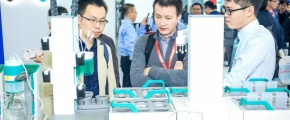Tutorial I: 亲水作用色谱技术
会议时间:10月31日 (9:30 – 11:00) Oct.31 (9:30 – 11:00)
会议地点:E1馆一楼M11会议室Room M11(1st floor) in Hall E1
主办单位:慕尼黑博览集团 Messe München
默克化工技术(上海)有限公司 Merck Chemicals (Shanghai) Co., Ltd.
会议主题:亲水作用色谱计划 Background and Theory for a better Understanding and successful Method Development and Application
演讲嘉宾: Frank Michel, Taufkirchen/DE, D.S. Bell, Bellefonte/US
参加会议注册链接:https://www.analyticachina.com.cn/zh-cn/visitor/register.html?ad_code=xLxzsGCClM
会议介绍 (英文):
Although known for more than three decades Hydrophilic Interaction Liquid Chromatography (named HILIC by Andrew Alpert in the beginning of the 1990ies [1]) experiences an increased interest especially in recent years. In this mode of chromatography, analyte retention increases monotonically with an increase in the organic component of the mobile phase. Applications of the technique have boosted dramatically over the past decade, especially for the analysis of polar analytes where reversed-phase chromatography usually fails. The higher retention of polar analytes achieved by HILIC provides improved selectivity, often leading to better qualitative and quantitative analyses [2]. Although HILIC chromatography is known to provide valuable retention and selectivity of polar compounds and to provide highly compatible conditions for coupling with mass spectrometry, it still often is avoided due to a lack of understanding the retention mechanisms issues and issues with robustness and repeatability.
The first part of this tutorial presents and discusses studies investigating the underlying retention mechanisms dominant in HILIC chromatography. Along with reversed-partitioning HILIC is well known to exhibit ion-exchange and other polar interactions. The interplay of these dominant mechanisms is unveiled and used to develop a model of overall retention and selectivity. The dependency of interactions on different stationary phase chemistries and conditions is presented. Throughout the discussion, examples of HILIC are employed to build a solid fundamental foundation for efficient and effective method development in this powerful technique.
In the second part fundamental investigations of factors contributing to robustness and repeatability are presented. Among others, the impact of sample solvent and equilibration procedures on retention times is investigated using several different HILIC stationary phases. Furthermore some phases in HILIC are known to mainly retain through ion-exchange interactions [3]. To enable these interactions a sound knowledge on pH of the mobile phase and pKa values is necessary. Measurements of pH values in the mobile phase as well as ionization constants (pKa/pKb) are often determined in aqueous environments only. But in HILIC mode usually high concentrations of acetonitrile are employed impacting both pH and pKa values, which may lead to a shift of both values possibly leading to change of the ionization state of the analytes and stationary phase in the HILIC. The results of the investigation of sample solvent, equilibration procedures and pH/pKa shifts provide valuable insight into HILIC retention mechanisms and will further improve future method development practices.
References:
[1] A.J. Alpert, J Chromatogr 499 (1990) 177–196
[2] P. Hemström, K. Irgum, J. Sep. Sci. 29 (2006) 1784 – 1821
[3] D.S. Bell, A.D. Jones, J Chromatog A 1073 (2005) 99
会议介绍 (中文):
虽然已经被发现三十多年,但学界近年来才开始对亲水性相互作用液相色谱(由Andrew Alpert在1990年命名为Helic [1])产生越来越浓厚的兴趣。在该色谱模式中,分析物的保留随着流动相的有机组分的增加而单调增加。在过去的十年中,该技术的应用有了显著的提高,特别是在反相色谱法难以实现的极性分析物的分析方面具有很好的应用。Helic实现了极性分析物的较高保留率,从而让选择性更高,能得到更好的定性和定量分析结果[2]。虽然已知Helic色谱能够实现极有价值的极性化合物保留率和选择性,并实现与质谱耦合的高度兼容的条件与,但因为保留机制缺乏理解,以及鲁棒性和可重复性的问题,大家仍然经常避免采用该方法。
本讲座的第一部分介绍和讨论HILIC色谱中占主导地位的对保留率机制的研究。除反向分区外,众所周知HILIC还表现出离子交换和其他极性相互作用的特征。讲座将揭示这些主导机制的相互作用,并用以开发整体的保留率和选择性模型。讲座还将介绍不同的固定相化学和条件的相互作用依赖关系。在讨论中,我们将介绍HILIC分析实例,建立该强大技术的有效分析方法的基础。
在第二部分中,我们介绍鲁棒性和可重复性影响因素的基础研究。我们使用几种不同的Helic固定相方法研究了样品溶剂和平衡过程对保留时间的影响。此外,已知HILIC中的某些阶段主要通过离子交换相互作用而保留[3]。为了实现这些相互作用,必须知道流动相的pH值和pKa值。流动相中的pH值以及电离常数(PKA/PKB)的测量通常仅在含水环境中测定。但是在HILIC模式中,通常使用高浓度的乙腈影响pH值和pKa值,这可能导致两个值的变化,并可能使在HILIC中分析物和固定相电离状态的改变。关于样品溶剂、平衡过程和pH/PKA位移的研究结果为揭示HILIC保留机制提供了有价值的见解,也促进未来方法开发的进一步改进。
参考文献:
[1] A.J. Alpert, J Chromatogr 499 (1990) 177–196
[2] P. Hemström, K. Irgum, J. Sep. Sci. 29 (2006) 1784 – 1821
[3] D.S. Bell, A.D. Jones, J Chromatog A 1073 (2005) 99
-
亲水作用色谱技术
-

弗兰克.米歇尔博士
Sigma-Aldrich (Merck子公司) | 分析与色谱科学顾问
Frank Michel博士在明斯特大学Jan T. Andersson教授的指导下完成博士阶段学习,开发、优化和评价HPLC中的新的固定相。
博士毕业后,Frank加入伯尼那生物系统公司担任分析化学家,开发和验证分析HPLC和其他方法在活性药物成分(API),包括赋形剂和药物等方面的分析方法。
后来,他又加入了Sigma-Aldrich公司,担任色谱产品专家,两年后成为中欧地区分析产品销售专家,主要从事色谱产品的市场营销,教学和开发。
他还在医药行业的分析服务提供商HWI Analytik公司负责分析服务和参考标准的市场营销。
弗兰克于2010回到Sigma-Aldrich(自2015年11月成为默克公司的子公司)担任分析和色谱技术专家,通过口头和书面讲座来传达公司的创新分析产品和新发展。他目前担任亚太地区的分析技术科学顾问。
弗兰克是德国化学家学会(GDCH)分离科学工作组成员,也是Analytix大会科学顾问委员会成员,对气体和液体分离的固定相化学特别感兴趣。在他的职业生涯中,弗兰克已经作了数百次色谱和分析相关讲座、研讨会和短训课程。亲水作用色谱技术
虽然已经被发现三十多年,但学界近年来才开始对亲水性相互作用液相色谱(由Andrew Alpert在1990年命名为Helic [1])产生越来越浓厚的兴趣。在该色谱模式中,分析物的保留随着流动相的有机组分的增加而单调增加。在过去的十年中,该技术的应用有了显著的提高,特别是在反相色谱法难以实现的极性分析物的分析方面具有很好的应用。Helic实现了极性分析物的较高保留率,从而让选择性更高,能得到更好的定性和定量分析结果[2]。虽然已知Helic色谱能够实现极有价值的极性化合物保留率和选择性,并实现与质谱耦合的高度兼容的条件与,但因为保留机制缺乏理解,以及鲁棒性和可重复性的问题,大家仍然经常避免采用该方法。
本讲座的第一部分介绍和讨论HILIC色谱中占主导地位的对保留率机制的研究。除反向分区外,众所周知HILIC还表现出离子交换和其他极性相互作用的特征。讲座将揭示这些主导机制的相互作用,并用以开发整体的保留率和选择性模型。讲座还将介绍不同的固定相化学和条件的相互作用依赖关系。在讨论中,我们将介绍HILIC分析实例,建立该强大技术的有效分析方法的基础。
在第二部分中,我们介绍鲁棒性和可重复性影响因素的基础研究。我们使用几种不同的Helic固定相方法研究了样品溶剂和平衡过程对保留时间的影响。此外,已知HILIC中的某些阶段主要通过离子交换相互作用而保留[3]。为了实现这些相互作用,必须知道流动相的pH值和pKa值。流动相中的pH值以及电离常数(PKA/PKB)的测量通常仅在含水环境中测定。但是在HILIC模式中,通常使用高浓度的乙腈影响pH值和pKa值,这可能导致两个值的变化,并可能使在HILIC中分析物和固定相电离状态的改变。关于样品溶剂、平衡过程和pH/PKA位移的研究结果为揭示HILIC保留机制提供了有价值的见解,也促进未来方法开发的进一步改进。
参考文献:
[1] A.J. Alpert, J Chromatogr 499 (1990) 177–196
[2] P. Hemström, K. Irgum, J. Sep. Sci. 29 (2006) 1784 – 1821
[3] D.S. Bell, A.D. Jones, J Chromatog A 1073 (2005) 99




























